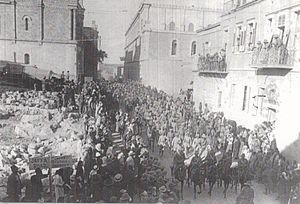| Second Transjordan attack on Shunet Nimrin and Es Salt | |||||||
|---|---|---|---|---|---|---|---|
| Part of the Middle Eastern theatre of World War I | |||||||
 Prisoners captured during the 2nd Transjordan operations marching through Jerusalem May 1918 | |||||||
| |||||||
| Belligerents | |||||||
|
| |||||||
| Commanders and leaders | |||||||
|
|
| ||||||
| Units involved | |||||||
|
60th (London) Division Anzac Mounted Division Australian Mounted Division Imperial Camel Corps Brigade Two Companies Patiala Infantry |
Fourth Army VIII Corps 3rd Cavalry Division Caucasus Cavalry Brigade 143rd Regiment 3rd and 46th Assault Companies 48th Division 703rd Infantry Battalion a storm battalion, a machine gun company and Austrian artillery | ||||||
| Strength | |||||||
| Unknown | 7,000 troops | ||||||
| Casualties and losses | |||||||
| 1,784 | Unknown | ||||||
The Second Transjordan attack on Shunet Nimrin and Es Salt,[citation needed] officially known by the British as the Second action of Es Salt [1] and by others as the Second Battle of the Jordan,[2] was fought east of the Jordan River between 30 April and 4 May 1918, during the Sinai and Palestine Campaign of the First World War. The battle followed the failure of the First Transjordan attack on Amman fought at the beginning April.[1][3] During this second attack across the Jordan River, fighting occurred in three main areas. The first area in the Jordan Valley between Jisr ed Damieh and Umm esh Shert the Egyptian Expeditionary Force (EEF) defended their advanced position against an attack by units of the Seventh Army based in the Nablus region of the Judean Hills. The second area on the eastern edge of the Jordan Valley where the Ottoman Army garrisons at Shunet Nimrin and El Haud, on the main road from Ghoraniyeh to Amman were attacked by the 60th (London) Division many of whom had participated in the First Transjordan attack. The third area of fighting occurred after Es Salt was captured by the light horse brigades to the east of the valley in the hills of Moab, when they were strongly counterattacked by Ottoman forces converging on the town from both Amman and Nablus. The strength of these Ottoman counterattacks forced the EEF mounted and infantry forces to withdraw back to the Jordan Valley where they continued the Occupation of the Jordan Valley during the summer until mid September when the Battle of Megiddo began.
In the weeks following the unsuccessful First Transjordan attack on Amman and the First Battle of Amman, German and Ottoman Empire reinforcements strengthened the defences at Shunet Nimrin, while moving their Amman army headquarters moved forward to Es Salt. Just a few weeks later at the end of April, the Desert Mounted Corps again supported by the 60th (London) Division were ordered to attack the recently entrenched German and Ottoman garrisons at Shunet Nimrin and advance to Es Salt with a view to capturing Amman. Although Es Salt was captured, the attack failed despite the best efforts of the British infantry's frontal attack on Shunet Nimrin and the determined light horse and mounted rifle defences of the northern flank in the Jordan Valley. However, the mounted yeomanry attack on the rear of Shunet Nimrin failed to develop and the infantry attack from the valley could not dislodge the determined Ottoman defenders at Shunet Nimrin. By the fourth day of battle, the strength and determination of the entrenched German and Ottoman defenders at Shunet Nimrin, combined with the strength of attacks in the valley and from Amman in the hills, threatened the capture of one mounted yeomanry and five light horse brigades in the hills, defending Es Salt and attacking the rear of the Shunet Nimrin position, forcing a retreat back to the Jordan Valley.
